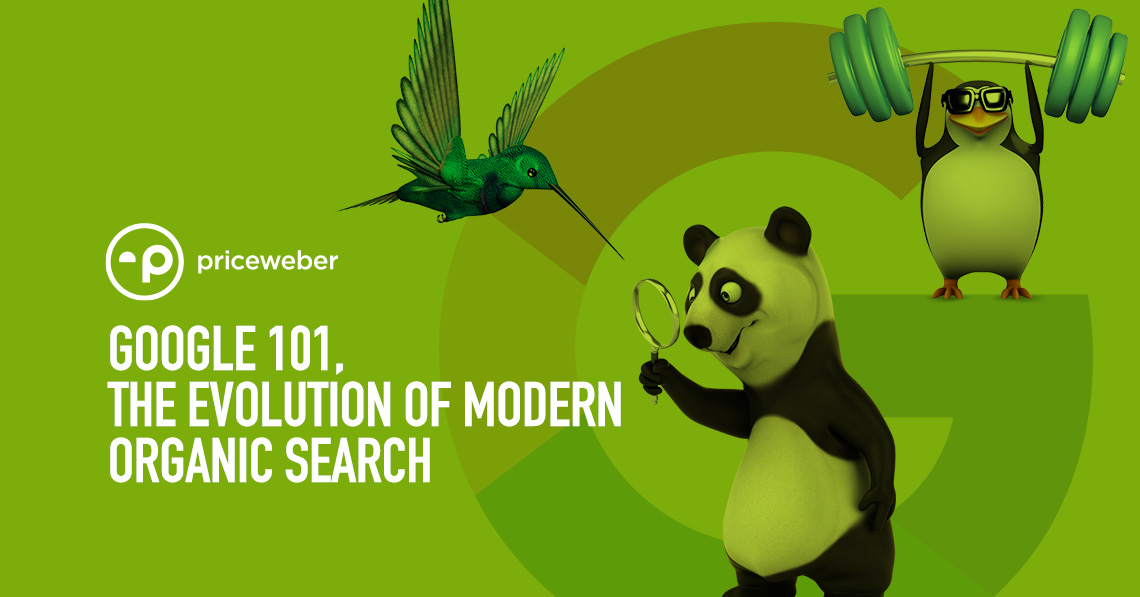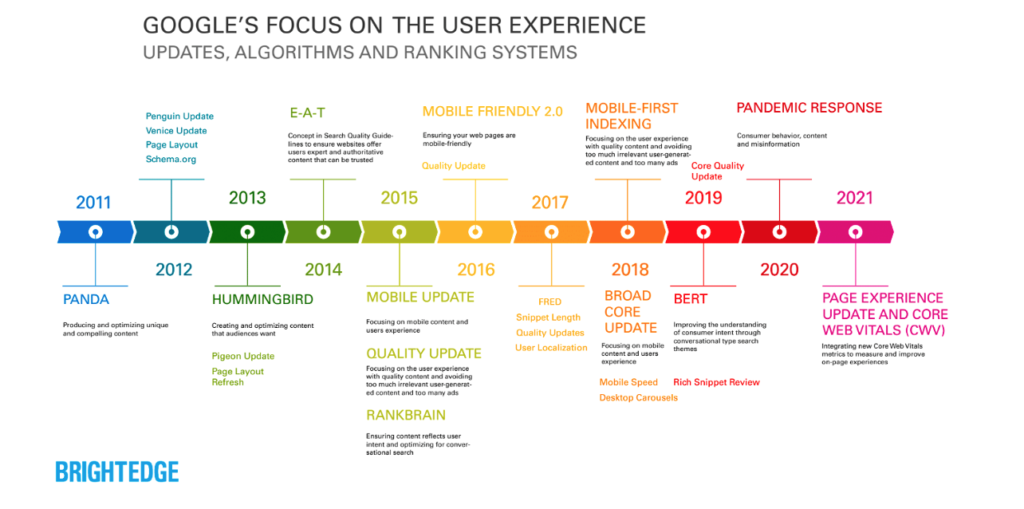“I’ll just Google it” has become instilled into every aspect of our lives, and for some reason, we place unconditional faith in computer code that has no face, personality, or distinctive trait that conveys a trustworthy outcome. Yet we continue to rely on the Google Search algorithm for daily wisdom, a great spot for pizza, or a cool new coffee shop, all through the filter of consumer reviews generated by happy (or passionately irritated) people and maps that show us how near our options are. And as marketers, we continue to seek an understanding of how our brands can consistently produce awesome search engine result page (SERP) rankings on Google. That’s a heavy lift without having some understanding of the engine that’s under the massive hood of the search hotrod that is Google. This edition of Plain Talk will be one of three articles that will tell you everything you ever needed to know to have a meaningful understanding of Google search algorithms and how they impact your brand.
What does Google care about?
Of course, they want to (and do) make a pile of money with paid search and display ads, but for today we’ll focus on organic search. When thinking about improving your search results, it helps to consider what Google cares about. In its mission statement, Google claims to want to “organize the world’s information and make it universally accessible and useful.” This means your search experience should allow you to “…discover a broad range of information from a wide variety of sources.” In short, they want you to have a good quality search experience and find what you need. This fairly relentless pursuit of a quality search experience led to their current search dominance, with 86% of desktop and 95% of mobile search traffic happening on Google Chrome. So, how does Google balance search speed with the quality of search results to deliver you that great search experience? The answer begins with a significant number of continuous updates that Google calls Everflux.
What is Google Everflux?
Even though it sounds like an awesome band name, Everflux is actually a web indexing process that constantly crawls sites to update search results and offer the best and most relevant experience for the 8.5 billion daily searches conducted. Simply put, Everflux keeps the digital gears greased between major core algorithm updates, and these unrelenting Everflux updates keep SEOs managers on their toes. Believe it or not, Google updates its algorithm 500 to 600 times a year, and these changes have a significant impact on search results, regardless of industry or location.
Impact can feel unpredictable
If you’ve ever looked at your SEO results and wondered why they seemed to tank suddenly, you’re not alone. The truth is that Everflux updates can feel a lot like Google is changing the rules in the middle of the game. That’s because they are. The influence of an update and its relative impact on your industry can vary and can take weeks before it impacts your SERP. So just when you thought you were safe, large swings in visibility, keyword rankings, and site traffic can take place and potentially impact your business.
The making of the modern Google search
To understand how this system and search has evolved to what it is today, let’s look at some of the most significant advancements that changed the search landscape, starting with major core algorithm changes called Panda, Penguin, and Hummingbird.
Google Panda
Birthday: February 23, 2011
Superpowers: Eliminates black hat SEO tactics and webspam and identifies duplicate content
Name Origin: Google engineer’s name (Biswanath Panda)
Why was the Panda update so significant in SEO?
As one of the most notable algorithm changes by Google, the target for this update was set to eliminate SEO tactics that were considered “black hat” and identify elements in contrast to best practices that impacted the quality of search results. With the Panda algorithm update, Google began to address low-quality web content associated with content farms that used outsourced contract writers. Ironically these content farms implemented Google AdSense to make money on the clicks within high-ranking webspam-type content.
Google wrote at the time that 11.8% of queries were impacted in search rankings by Panda, and some brands were forced to change names, adopt new ways of content distribution or shut their doors entirely due to such a significant update in how content was measured and ranked on Google. Some of these notable brands included Demand Media (now called Leaf Group), eHome, and Livestrong, which placed so much attention on keywords that the dramatic reduction in rankings caused swift changes in online revenue leading to closures and layoffs of skilled digital marketers.
After the initial Panda reign of destruction, a series of updates spanned two years and included nine updates in 2011 and 14 updates in 2012, but an official statement from Google notes that Panda was officially incorporated into the core Google algorithm on July 16, 2016.
Did Panda save Google’s market share?
Despite the initial disruption to brands when Panda launched, the change has likely helped both Google and honest brands. If content farms were allowed to flourish, Google could have experienced content overflow that would have made the customer’s search experience worse and complicated the missions of advertisers and SEO professionals who would have had to sift through mountains of data to manage their SERP.
Google Penguin
Birthday: April 24, 2012
Superpowers: Devalue link schemes, keyword stuffing
Name Origin: Nothing cool; we think they just liked penguins
Did the Penguin update end backlink spam?
Penguin, also known as the webspam algorithm update, was launched in 2012, and after its final version, Penguin 4.0, is now a permanent part of the Google search algorithm. Unlike Panda, Penguin doesn’t need to be updated on a regular basis and works in real-time to provide quick ranking adjustments based on how Google calculates trust from inbound links supporting domains and individual pages. Deep measures were taken to drastically reduce and place an end to the backlink spam that benefited many websites that were taking shortcuts, buying or automating black hat backlinking and keyword efforts.
We still can see remnants of decade-old link schemes, content spam, and low-quality websites that concentrated on keywords rather than context, but for most of the websites, these old tactics seldom require deep retooling. Google has provided a great compromise in devaluing a spam link’s authority to provide neither a negative nor positive ranking factor to the target website.
Google Hummingbird
Birthday: September 2013
Superpowers: Precision, speed, and NLP
Name Origin: Quick and nimble bird
How does the Hummingbird update impact SEO?
The name Hummingbird was attributed to the “speed” and “accuracy” the update would provide for better SERPs. The Hummingbird update was implemented in September 2013. In simple terms, Hummingbird targets meaning and context instead of just individual keywords. In nerd terms, that means Google decided to provide a better reading experience within search results by leveraging Natural Language Processing (NLP) and focusing on conversation and meaning to deliver the best search results. Post-Hummingbird, writers were encouraged to concentrate on high-quality, well-written content and stop force-feeding keywords into their copy to achieve top rankings.
The Hummingbird update to Google’s search algorithm made significant changes to the user experience. It was designed to better understand users’ intent when searching for information online while understanding longer and more conversational search queries.
The Hummingbird update has been called a major change in how Google’s algorithm works. The biggest change was the elimination of one-to-one keyword matching. For brands, this algorithm change is consistent with using search to strike up virtual “conversations” with prospective customers by allowing them to significantly narrow and personalize how they search.
So, what’s next?
There have been some major shifts in the way we navigate our lives in the digital space, and one thing is certain – Google will continue to improve the core algorithm to defend its position as the leader in search and to accommodate our insatiable need for information at our fingertips. As devices evolve into small compact platforms, including wearables in augmented reality, our ability to access data will increase the demand for higher-quality search results with close to zero latency.
In the next installations of our three-part SEO series, we will dig into how mobile and voice search have continued to pressure Google engineers to evolve your customer’s search experience with changing time and technology. If you have any questions or want to talk SEO in the meantime, give us a call at 502-499-4209 or drop us a note here, and we’ll be happy to help.





